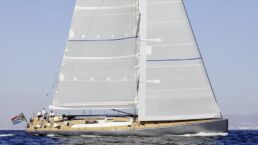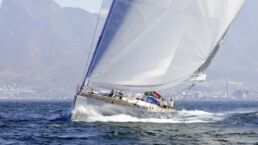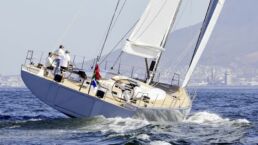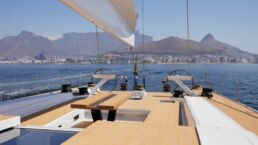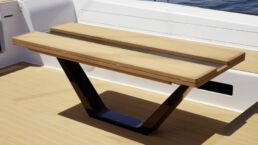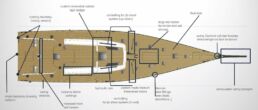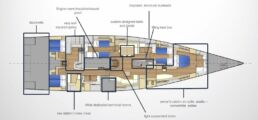Can your home race 25 knots, just powered by the wind? The SW-RP90 CUSTOM ALL SMOKE, developed by Reichel/Pugh can!
Photos by Peter Schreiber
The SW-RP90 CUSTOM ALL SMOKE is the owner’s vision of a home during regattas and bluewater journeys. The design studio developed her as “ultralight Fast Performance Cruiser” thanks to the extensive use of carbon fiber for the hull, the deck, bulkheads et cetera — Furthermore, the calculations of the very experienced design office for performance-oriented sailing yachts and flexible sailing setups. The boat is a construction by the South African-based shipyard Southern Wind. Mast and boom are also carbon constructions, delivered by Southern Spars to set almost 500 m² (upwind) and over 1000 m² (downwind) haute couture by North Sails to power her up to 25 knots. Nauta Design also created the interior design while Reichel/Pugh made the arrangement. Unfortunately, there are no interior photos available at the date of publishing.
The yacht has a length of 27.50m, a beam of almost seven meters, and a minimum draft of 3.80m to reach shallow waters. When the boat is under sails, the 20-ton keel can be lowered down to 5.80m in under one minute.
Fast & Furious - with the comfort of a cruising yacht
The passionate owner asked for
“a very fast yacht with the comfort and safety standards typical of a cruising yacht but versatile enough for both fast cruises with family and excellent performance in the most renowned offshore and inshore superyacht regattas,”
says Willy Persico, founder, and CEO of Southern Wind Shipyard.
To gain more comfort, Southern Wind installed anti-vibration mountings and insulation to reduce any sound from the engine to minimum. SWS worked with Van Capellen – a Dutch company highly-specialized in noise and vibration control on luxury yachts.
The owner’s cabin is forward located, the guest area amidships. The crew area with galley is at the aft and has its own ladderway close to the helm station to work without disturbing guests.
“Our challenge was to design interiors that were intriguing and innovative but with ergonomics that could function within the structural and dimensional constraints that the performance aspects of the yacht’s design imposed,”
commented Massimo Gino and Mario Pedol, founders and co-heads of Nauta Design.
Developing the performance of a sailing yacht is not just calculating lines; it is also to save weight. According to the saying: “A penny saved is a penny earned”, Reichel/Pugh developed the hydraulic anchor arm also in carbon fiber. That saves about 53 % of weight in comparison with conventional aluminum constructions.
During a race, it is essential to change and store sails like a big code zero or a gennaker very fast. ALL SMOKE got storage under a foredeck hatch isolated from the living area to stack hundred pounds of sails. The storage is large enough to store also a tender.
Transforming into the racing mode
There are a few fine-tuning steps to turn the fast bluewater cruiser into the racing mode.
- Removing the heavy anchor including the chain
- Mounting the bowsprit
- Replacing the pinhead mainsail with a square-topped sail
- Using a twin backstay instead of the cruising centerline backstay
- Removing some cruising amenities
During her sea trials in cruising mode, she reached a speed of 18 knots.
Main Specifications of ALL SMOKE
| Length over all: | 27.50 m |
| Length waterline: | 26.50 m |
| Beam: | 6.96 m |
| Draft: | 3.80 - 5.80 m |
| Displacement: | 47.75 tons |
| Total Sail Area: | 469 m² |
| I: | 35.70 m |
| P: | 37.40 m |
| J: | 10.80 m |
| E: | 12.20 m |
| Fuel Capacity: | 2450 l |
| Fresh Water: | 1140 l |
Deck Layout & General Arrangement
SHARING IS CARING - THANK YOU!
About Publisher
 Ahoy, I’m René, the “captain” of this luxury yacht blog, and found my passion for the big ones at the age of 17. I have grown up with sailing since a little child. I have an education in Business Informatics and specialized in digital media solutions (alongside luxury yachts) like Online-Marketing, User Experience Design et cetera. My home port is in Oldenburg, Germany next to Lürssen and Abeking & Rasmussen. More about yachtemoceans
Ahoy, I’m René, the “captain” of this luxury yacht blog, and found my passion for the big ones at the age of 17. I have grown up with sailing since a little child. I have an education in Business Informatics and specialized in digital media solutions (alongside luxury yachts) like Online-Marketing, User Experience Design et cetera. My home port is in Oldenburg, Germany next to Lürssen and Abeking & Rasmussen. More about yachtemoceans
